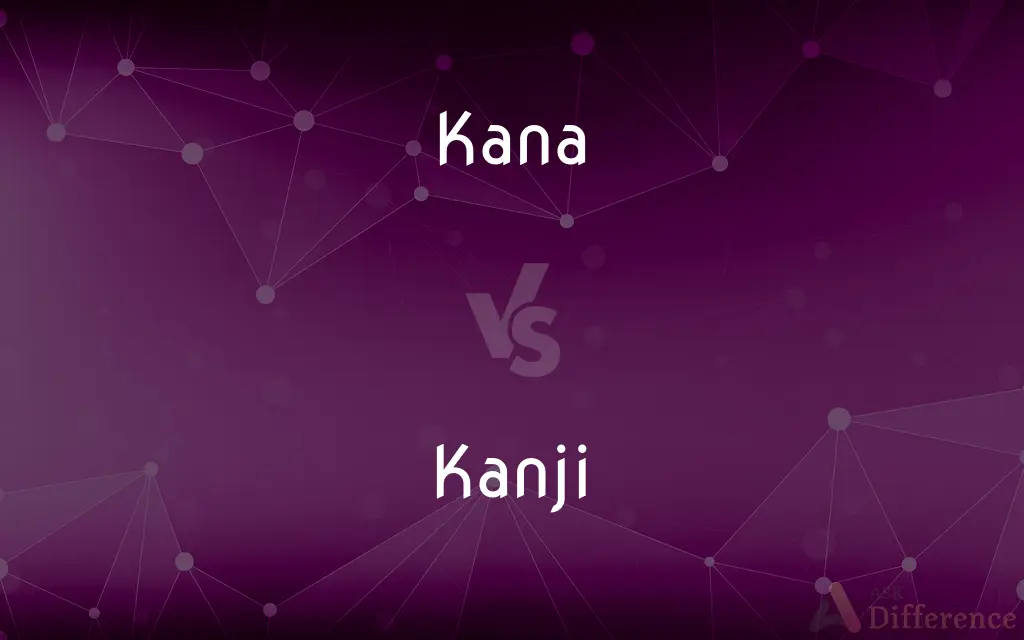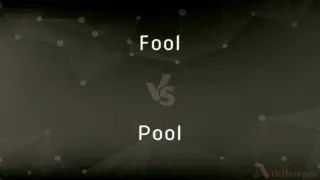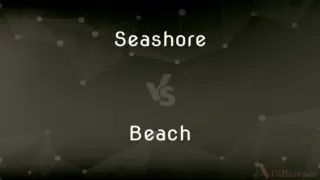Kana vs. Kanji — What's the Difference?
Edited by Tayyaba Rehman — By Maham Liaqat — Updated on March 31, 2024
Kana represents syllabic sounds in the Japanese writing system, while Kanji are characters borrowed from Chinese, representing words or concepts.

Difference Between Kana and Kanji
Table of Contents
ADVERTISEMENT
Key Differences
Kana is divided into two types: Hiragana, used for native Japanese words, and Katakana, for foreign words and names. These phonetic symbols are used for inflectional endings, grammatical particles, and words without Kanji. In contrast, Kanji conveys meanings and sounds, derived from Chinese characters, and each Kanji can have multiple readings based on context and combinations. Kana facilitates reading by providing phonetic guides, especially for Kanji pronunciations, while Kanji compactly conveys complex concepts or ideas, often needing multiple Kana to express the same.
Learning Kana is generally easier and the first step for beginners in Japanese due to its limited set of characters (46 in each Hiragana and Katakana) and straightforward phonetic nature. On the other hand, Kanji learning is more challenging, with thousands of characters and multiple readings, but it's essential for fluency and literacy in Japanese, enabling readers to quickly grasp meanings in texts.
The use of Kana alongside Kanji in Japanese texts aids readability and comprehension. Kana marks grammatical functions and aids in deciphering Kanji readings, while Kanji reduces sentence length and clarifies meaning, as many Japanese words share pronunciations but differ in meaning.
In modern Japanese, a balance between Kana and Kanji is maintained for clarity and efficiency. Purely Kana texts can be harder to understand due to the lack of conceptual distinctions Kanji offers, whereas excessive Kanji use can make texts dense and difficult to read. This balance allows for nuanced expression, combining the phonetic representation of Kana with the semantic depth of Kanji.
Comparison Chart
Nature
Phonetic symbols representing syllables.
Logographic characters representing words or concepts.
ADVERTISEMENT
Types
Hiragana and Katakana.
Thousands of characters borrowed from Chinese.
Use
Grammatical particles, inflections, foreign words.
Core vocabulary, names, and specific concepts.
Learning
Easier, limited set of characters.
More challenging, multiple readings and meanings.
Function in Text
Indicates pronunciation, grammatical structure.
Provides meaning, reduces text length.
Compare with Definitions
Kana
Used for foreign names and loanwords.
コンピュータ (konpyūta) means computer in Katakana.
Kanji
Kanji conveys complex ideas succinctly.
速 (はやい, hayai) means fast or quick.
Kana
Kana often accompanies Kanji to indicate pronunciation.
美しい (うつくしい, utsukushii) uses Hiragana to phonetically express the adjective beautiful.
Kanji
Each Kanji has a specific meaning.
水 (みず, mizu) means water.
Kana
Used for native Japanese words.
あいうえお (aiueo) are the first five Hiragana characters, representing basic vowels.
Kanji
Kanji have On'yomi and Kun'yomi readings.
大 (おお, oo; だい, dai) means big with two readings.
Kana
Hiragana is used for verb and adjective conjugations.
食べる (たべる, taberu) means to eat, with the verb base in Kanji and the inflection in Hiragana.
Kanji
Kanji characters are derived from Chinese.
学 (がく, gaku) means study or learning.
Kana
Kana indicates grammatical relationships.
は (wa) as a topic marker in sentences.
Kanji
Kanji adds conceptual meaning to sentences.
愛 (あい, ai) means love.
Kana
Kana (仮名, Japanese pronunciation: [kana]) are syllabaries used to write Japanese phonological units, morae. Such syllabaries include: (1) the original kana, or magana (真仮名, literally 'true kana'), which were Chinese characters (kanji) used phonetically to transcribe Japanese; the most prominent magana system being man'yōgana (万葉仮名); the two descendants of man'yōgana, (2) cursive hiragana (平(ひら)仮(が)名(な)), and (3) angular katakana (片(カタ)仮(カ)名(ナ)).
Kanji
Kanji (漢字, pronounced [kaɲdʑi] (listen)) are the adopted logographic Chinese characters that are used in the Japanese writing system. They are used alongside the Japanese syllabic scripts hiragana and katakana.
Kana
Japanese syllabic writing. The characters are simplified kanji and are usually used with kanji primarily to write inflections, particles, and function words and to show the pronunciations of some kanji and of all foreign words.
Kanji
A Japanese system of writing based on borrowed or modified Chinese characters.
Kana
Any of the characters used in this system.
Kanji
A character used in this system of writing.
Kana
The hiragana and katakana syllabaries. These are made up of characters that represent individual syllables, which are are used to write Japanese words and particles. Kana are derived from kanji.
Kanji
(uncountable) The system of writing Japanese using Chinese characters.
Japanese is written in a mixture of kanji and kana.
Kana
A hiragana or katakana character.
Kanji
Any individual Chinese character as used in the Japanese language.
I know about a thousand kanji.
Kanji
A North Indian fermented drink made with beetroot and carrots.
Common Curiosities
How does Kana differ from Kanji in usage?
Kana is used for grammatical functions and phonetic guidance, while Kanji represents core vocabulary and concepts.
Can Japanese be written without Kanji?
Technically yes, but it would be less concise and could lead to ambiguities due to the lack of conceptual distinctions provided by Kanji.
What is Kana?
Kana are syllabic characters in the Japanese writing system, consisting of Hiragana and Katakana.
How are Hiragana and Katakana different?
Hiragana is used for Japanese words and grammatical elements, while Katakana is for foreign words, names, and onomatopoeia.
How many Kanji does a literate Japanese person know?
A literate adult typically knows around 2,000 to 3,000 Kanji, which covers the most common usage.
Why are there two types of Kana?
The distinction allows for a clear differentiation between native Japanese words and grammatical functions (Hiragana) and foreign loanwords or specific names (Katakana).
Is it possible to fully understand Japanese without learning Kanji?
While basic conversation can be managed without Kanji, full literacy and understanding of written texts require learning Kanji.
How does Kanji affect the length of Japanese texts?
Kanji reduces the physical length of texts by representing complex ideas with single characters, unlike Kana, which requires more space for phonetic spelling.
Why is Kana considered easier to learn than Kanji?
Kana has a limited set of characters with direct phonetic correlation, unlike Kanji's thousands of characters with multiple meanings and readings.
What is Kanji?
Kanji are logographic characters in Japanese, borrowed from Chinese, representing words or concepts.
How do digital technologies affect the use of Kana and Kanji?
Digital technologies have made it easier to input and read both Kana and Kanji, supporting the continued use and learning of these characters.
What role does Kana play in reading Kanji?
Kana is used alongside Kanji to provide pronunciation guides and grammatical context, aiding in comprehension.
What is the significance of Kanji in Japanese culture?
Kanji carries cultural and historical significance, reflecting centuries of linguistic development and cultural exchange with China.
What are On'yomi and Kun'yomi readings in Kanji?
On'yomi are Chinese-derived readings, while Kun'yomi are native Japanese readings, reflecting the dual origin of Kanji usage.
Can Kana and Kanji be mixed in a single word?
Yes, many Japanese words combine Kanji with Hiragana for verb and adjective conjugations, as well as for disambiguating readings.
Share Your Discovery

Previous Comparison
Fool vs. Pool
Next Comparison
Seashore vs. BeachAuthor Spotlight
Written by
Maham LiaqatEdited by
Tayyaba RehmanTayyaba Rehman is a distinguished writer, currently serving as a primary contributor to askdifference.com. As a researcher in semantics and etymology, Tayyaba's passion for the complexity of languages and their distinctions has found a perfect home on the platform. Tayyaba delves into the intricacies of language, distinguishing between commonly confused words and phrases, thereby providing clarity for readers worldwide.















































